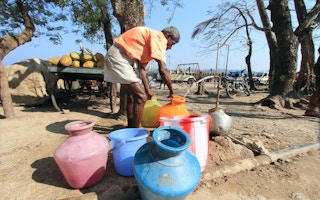The American West is still in the grip of severe drought. Twelve US states are experiencing extreme drought, and California and parts of Nevada are experiencing exceptional drought – the worst in decades.
To continue reading, subscribe to Eco‑Business.
There's something for everyone. We offer a range of subscription plans.
- Access our stories and receive our Insights Weekly newsletter with the free EB Member plan.
- Unlock unlimited access to our content and archive with EB Circle.
- Publish your content with EB Premium.
For millions of Americans, the lack of water is hitting close to home, but they are not alone. With global water use growing at more than twice the rate of population increase in the last century (according to UN Water for Life 2005-2015), and climate change also straining the global water cycle, by 2025 fully one-third of the world’s population will be affected by water shortages.
The amount of water we have is both a natural and human-made phenomenon. But while controlling the climate and rainfall is somewhat out of our reach, we can be resolute on controlling the efficiency in which we use-up existing water quantities.
Caring for its even distribution, reducing wastage and pollution, and optimizing management can ultimately mitigate the impacts of water shortages.
We must start thinking how we can be smarter, better steward of water abundance.
More than a third of the world’s drinking water supply is lost in urban distribution systems before it even reaches consumers. Undetected underground leaks, aging infrastructure, outmoded systems, and mismanagement amount to over $18 billion a year in lost revenue, failed crops, and emergency repairs.
The most sustainable and cost-effective way to alleviate such losses, increase supply, and bridge the demand gap is to improve the efficiency of urban water distribution systems by effective water loss management. It is also the responsible and values-driven approach we can all take.
Here are some of the key elements we found to be important, in achieving successful and sustainable water distribution.
- Comprehensive Solutions – It’s key to tailor a sustainable and bespoke solution specifically for each project. It is important to take into account the interrelatedness of components in the entire system, identifying and incorporating the many elements through analysis, study, design, implementation, training, and maintenance. By dynamically integrating the various complementing activities, the project’s technical aspects can be managed sustainably.
- Flexible business model – Performance-based compensation can achieve shared risk, alignment of interests, and investment in the system based on projected results. This is fundamental especially for partner utilities in EM, where alternative bidding methods streamlines the complex financing processes.
- Quality-based tendering – When dealing with an efficacy project, success and long-term sustainability should be of the highest importance. Public tenders that focus on the quality and experience brought-in by the bidding companies, rather than price, can increase chances of project success. While budgetary frameworks are the backbone on which proposals are built, design-to-cost tendering must not overshadow the optimal solution. Any player can negotiate the price, but quality, experience, and proven success are non-negotiable facts.
- Integration of technologies – When we think of technology, we easily get persuade by “best of bread”. At times it will be the correct approach. However, in an output-based project, first consider the projected return/saving achieved by implementing the cutting-edge technology. Therefore, some “luxury” technologies could, and at times should be delayed until the water utility is better equipped to get the most out of it.
- Building local capacity – Projects start and end, players come and go… Increasing the professionalism and skills of the local workers is primarily crucial, because this enables the utility to maintain the successful project well after its completion. Only through the skilled care of those on the job at any point in time, can the system be properly maintained over time, ensuring efficiency, driving growth, guarantying sustainability. And this was the very reason for the project to begin with.
Meir Wietchner has been serving as chief strategy officer of Arison Investments since 2010. He is also the chairman of Miya, and was Miya’s CEO for four years (2009-2012). As CSO, Wietchner applies his managerial and technological experience of over 28 years. Wietchner holds an MBA from Northwestern University (2003), and a BSc in Computer Science and a BA in Political Science, both from Bar Ilan University (1988).









